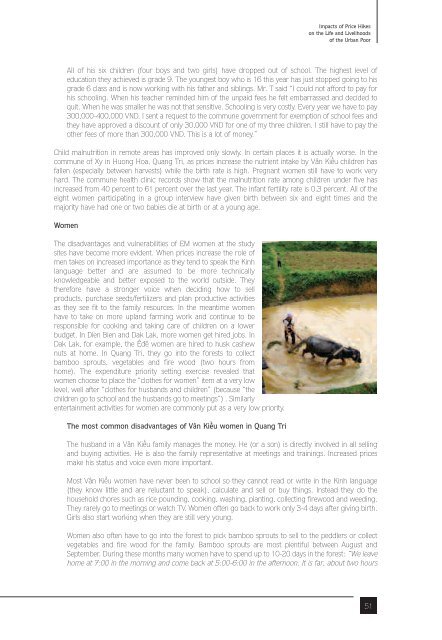Untitled - Oxfam Blogs
Untitled - Oxfam Blogs
Untitled - Oxfam Blogs
You also want an ePaper? Increase the reach of your titles
YUMPU automatically turns print PDFs into web optimized ePapers that Google loves.
Impacts of Price Hikes<br />
on the Life and Livelihoods<br />
of the Urban Poor<br />
All of his six children (four boys and two girls) have dropped out of school. The highest level of<br />
education they achieved is grade 9. The youngest boy who is 16 this year has just stopped going to his<br />
grade 6 class and is now working with his father and siblings. Mr. T said “I could not afford to pay for<br />
his schooling. When his teacher reminded him of the unpaid fees he felt embarrassed and decided to<br />
quit. When he was smaller he was not that sensitive. Schooling is very costly. Every year we have to pay<br />
300,000-400,000 VND. I sent a request to the commune government for exemption of school fees and<br />
they have approved a discount of only 30,000 VND for one of my three children. I still have to pay the<br />
other fees of more than 300,000 VND. This is a lot of money.”<br />
Child malnutrition in remote areas has improved only slowly. In certain places it is actually worse. In the<br />
commune of Xy in Huong Hoa, Quang Tri, as prices increase the nutrient intake by Vân Kiu children has<br />
fallen (especially between harvests) while the birth rate is high. Pregnant women still have to work very<br />
hard. The commune health clinic records show that the malnutrition rate among children under five has<br />
increased from 40 percent to 61 percent over the last year. The infant fertility rate is 0.3 percent. All of the<br />
eight women participating in a group interview have given birth between six and eight times and the<br />
majority have had one or two babies die at birth or at a young age.<br />
Women<br />
The disadvantages and vulnerabilities of EM women at the study<br />
sites have become more evident. When prices increase the role of<br />
men takes on increased importance as they tend to speak the Kinh<br />
language better and are assumed to be more technically<br />
knowledgeable and better exposed to the world outside. They<br />
therefore have a stronger voice when deciding how to sell<br />
products, purchase seeds/fertilizers and plan productive activities<br />
as they see fit to the family resources. In the meantime women<br />
have to take on more upland farming work and continue to be<br />
responsible for cooking and taking care of children on a lower<br />
budget. In Dien Bien and Dak Lak, more women get hired jobs. In<br />
Dak Lak, for example, the Êđê women are hired to husk cashew<br />
nuts at home. In Quang Tri, they go into the forests to collect<br />
bamboo sprouts, vegetables and fire wood (two hours from<br />
home). The expenditure priority setting exercise revealed that<br />
women choose to place the “clothes for women” item at a very low<br />
level, well after “clothes for husbands and children” (because “the<br />
children go to school and the husbands go to meetings”) . Similarly<br />
entertainment activities for women are commonly put as a very low priority.<br />
The most common disadvantages of Vân Kiu women in Quang Tri<br />
The husband in a Vân Kiu family manages the money. He (or a son) is directly involved in all selling<br />
and buying activities. He is also the family representative at meetings and trainings. Increased prices<br />
make his status and voice even more important.<br />
Most Vân Kiu women have never been to school so they cannot read or write in the Kinh language<br />
(they know little and are reluctant to speak), calculate and sell or buy things. Instead they do the<br />
household chores such as rice pounding, cooking, washing, planting, collecting firewood and weeding.<br />
They rarely go to meetings or watch TV. Women often go back to work only 3-4 days after giving birth.<br />
Girls also start working when they are still very young.<br />
Women also often have to go into the forest to pick bamboo sprouts to sell to the peddlers or collect<br />
vegetables and fire wood for the family. Bamboo sprouts are most plentiful between August and<br />
September. During these months many women have to spend up to 10-20 days in the forest: “We leave<br />
home at 7:00 in the morning and come back at 5:00-6:00 in the afternoon. It is far, about two hours<br />
51

















